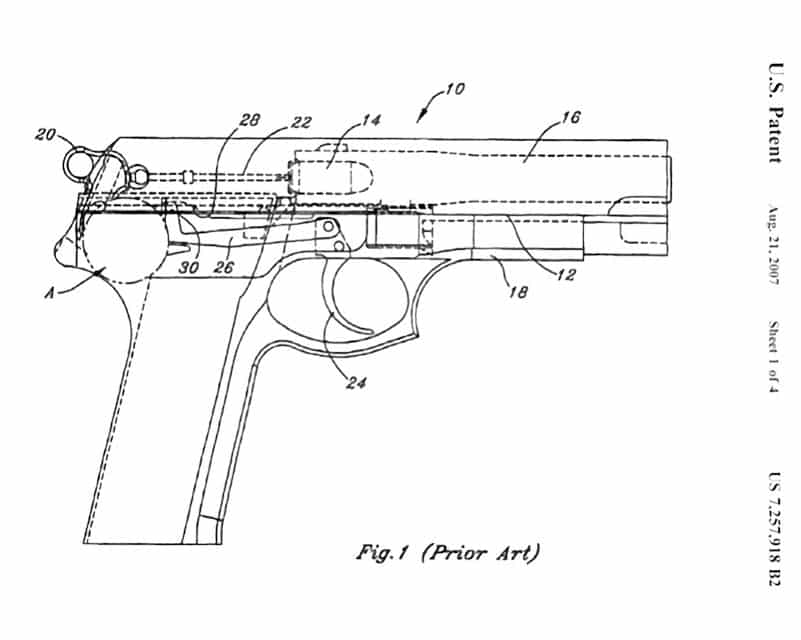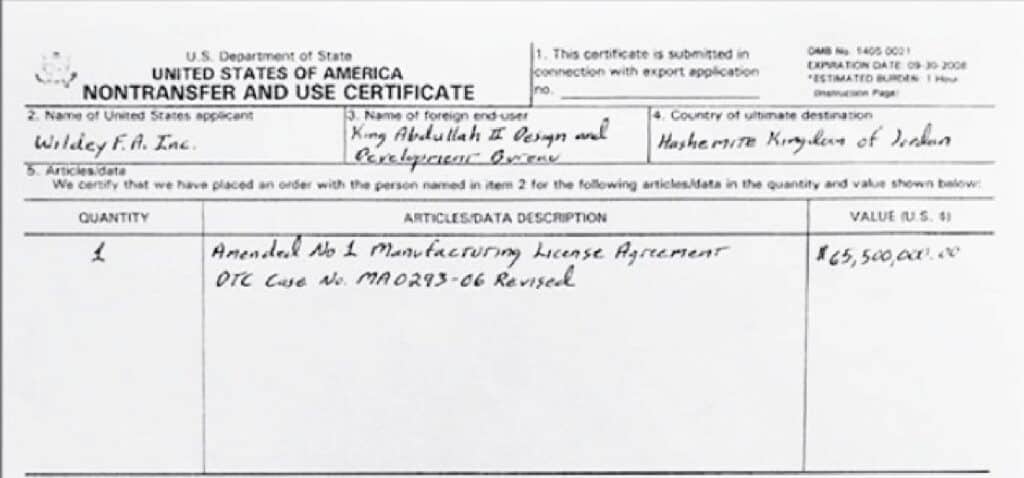“Wildey’s here.”
Not only is this the line uttered by Charles Bronson in 1985’s Death Wish III, which served to introduce the world to the Wildey Survivor pistol, but it’s also the title of Wildey Moore’s autobiography, published in 2019. You may already be aware of Wildey Moore, and his work in the firearms industry. Not only has he designed iconic pistols, he was also responsible for founding the country of Jordan’s Jordan Armament & Weapon Systems (JAWS) state arms factory.
Moore grew up in New York City and he would go on to serve as a Weapons Mechanic in the U.S. Air National Guard during the Korean War (1950-1953). It was here that he really developed his knowledge of firearms design while working on standard-issue firearms, such as the M1911A1 pistol and the U.S. M1 rifle (more commonly known as the .30-06 M1 Garand). After his enlistment in the Air National Guard was up, Moore went to work for several firearms companies including famous American firms such as Stoeger and Winchester. After making a name for himself within the U.S. firearms industry, the Swedish government owned Forenade Fabrikwerken hired Moore as their new U.S. sales representative and design consultant. While working for this firm, Moore was introduced to a set of gas-operated pistol prototypes chambered in 9×19mm and designed, he believed, in the 1940s. Moore saw potential in these forgotten gas-operated pistols, and it was at this point he struck out on his own. Several years later, in 1973, Moore introduced his massive, adjustable, gas-operated Survivor pistol, which was initially chambered in 45 Winchester Magnum.

Moore’s Survivor pistol was featured in the U.S. film “Death Wish III”. This starring role, as well as other press in the firearms industry, caught the eye of a certain “gun nut”, in the words of Moore, none other than His Majesty Prince Abdullah II bin Al-Hussein of Jordan. Today, Abdullah II, King of Jordan, but back then, in the late 1980s, he was Prince Abdullah. The prince made it known to Moore that he had a great desire to see Jordan develop its own domestic firearms production capability. It would take another decade, when Abdullah II ascended the throne of Jordan in 1999 that these plans would finally be set in motion.
In the spring of 2000, King Abdullah II sent for Moore and set him to the task of building up Jordan’s new firearms manufacturing infrastructure. Moore soon found that Jordan lacked even the most basic manufacturing requirements for producing firearms, but with the King’s backing via The King Abdullah Design and Development Bureau (KADDB), Moore soon acquired machinery and tooling from Germany. This would form the Royal Jordanian Machining Center, which would, in turn, supply parts for JAWS. As the first product of JAWS, Moore designed a handgun, which would be called “Viper.” Moore earned three U.S. patents on the Viper pistol.


In addition to the patented design features, the JAWS Viper was to be a multi-caliber handgun with rotary barrel, short-recoil action, and ambidextrous controls. The Viper had the makings of a unique and interesting handgun, but it was not to play out that way. In 2006, just as the Viper was ready for mass production at JAWS, Moore suffered a stroke that essentially crippled him, and he was never again able to travel to Jordan. Concurrently, there were changes in leadership at KADDB (the parent organization of JAWS), and that new leadership sought to remove Moore from his position at JAWS entirely. This eventually led to Moore suing JAWS, KADDB, and even the King of Jordan himself. To avoid the press of a trial, the King of Jordan returned his own 51% interest in JAWS as well as Moore’s personal company (Wildey FA) at no cost. The lawsuit was subsequently dropped. Moore eventually sold Wildey FA and the rights to his Survivor pistol to Charlie Rhoades in 2015, and he now lives at home in Connecticut with his wife, Linda.

“Wildey’s Here” is an autobiography, written and published by Wildey Moore himself; it’s not meant to be a reference book, rather it is Moore’s recounting of his life and experiences. For example, throughout the book Moore often tells anecdotal stories that, while making for entertaining reading, must be taken with a grain of salt. In one of these accounts, Moore describes showing the Viper pistol to Mikhail Kalashnikov, as follows:
“It further helped that the gun had the blessing of Mikhail Kalashnikov. In Abu Dhabi, I had the privilege of having him critique the Viper pistol. By this point he was already well into his 80s and approaching 90. He took the pistol and examined it thoroughly. When he finished, Kalashnikov took off his tie pin and gave it to me as a sign and as a medal of his approval. This was his way of honoring the design. It’s hard to think of a better endorsement than from the designer of the greatest assault rifle of the 20th century. The Viper pistol had arrived and not only that, but people knew it.”

Did Kalashnikov truly approve of the design, or was he simply being polite to a fellow designer? That is a question that cannot be definitively answered. Another aspect of Moore’s autobiography is that he often injects his own personal political and religious beliefs at random times.
In one example he suggests that the Bush family’s interests in a defense company, The Carlyle Group, has seen both President George H.W. Bush and George W. Bush seek war in order to stoke profits for the company. In another section, he laments that the institution of marriage was not what it once was and that, “the necessity of salvation is further obscured by our language which has been perverted to the point where meaning can be difficult to apprehend.”

in the slide, the removable side plate, and the rotary unlocking barrel. MAXIM POPENKER
While Moore is verbose regarding his personal beliefs, he is relatively sparse with any description or technical data regarding the JAWS Viper handgun. He only briefly mentions the three patents listed above in the following quote:
“What we eventually made of the Viper was a semi-automatic pistol with the capability of rapidly accepting different calibers by a simple exchange of barrels, extractors, bolt faces, and magazines. I was awarded three new patents in the U.S. during the development stage, patents which have gained worldwide recognition in every country JAWS has filed for them. The first of these was the double action hammer trigger mechanism; the second was for a removable bolt face; the third was for a readily removable side plate.”


This lone paragraph is the only description of the JAWS Viper handgun throughout the entire book. Considering how proud Moore was of his other work and beliefs, it is a shame that he barely bothers to describe what was arguably his greatest design. Perhaps his minimal discussion of the pistol is an effort to protect his work, though this seems at odds with the intended audience for the book, who will be most interested in Moore’s firearms. The Viper was the product that was to launch a firearms manufacturing revolution in Jordan, and its design was worthy of more than three sentences in this book.

“Wildey’s Here” does exactly what it was meant to do. It gives us an up-close and personal look at the life of a proud firearms designer. We definitely come out of reading this book with a better understanding of Wildey Moore. Where it comes up short is where it most concerns researchers of MENA-based firearms history. We are given only a small dose of the Viper pistol that was to initiate domestic firearms manufacturing in Jordan. From the little Moore gives us, we see a pistol with many features that were almost ahead of their time. While DA/SA semiauto pistols were all the rage in the late 90s and early 2000s (when the Viper was conceived), ambidextrous controls were still a novelty, rather than the norm. The photos included with this review show a pistol that reminds me of popular self-loading pistols of that era (Beretta M92, SIG P226, and even the Ruger P85) while having a design as unique as its designer. It’s sad that this pistol did not see more than a paltry production (only 150 or so were made for the Palace Guard, according to Moore), and that Mr. Moore could not provide the research community with more details and primary source documentation on the JAWS Viper.
—
This article originally appeared at Silah Report, a project of Armament Research Services (ARES) monitoring arms and munitions developments in the Middle East, North Africa, and Central Asia. More original material is available at: www.silahreport.com.
| This article first appeared in Small Arms Review V26N5 (May 2022) |












